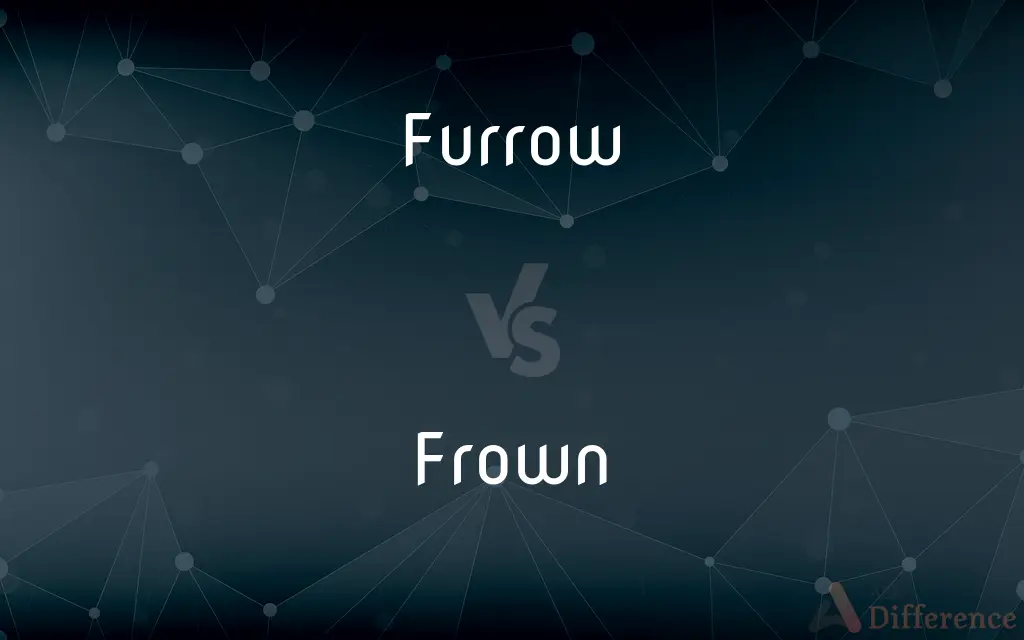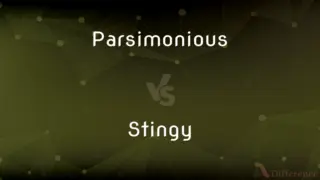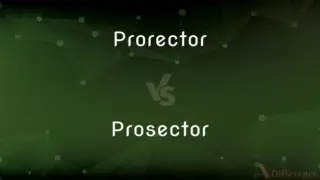Furrow vs. Frown — What's the Difference?
By Fiza Rafique & Maham Liaqat — Updated on March 27, 2024
A furrow refers to a narrow groove made in the soil, while a frown is a facial expression indicating disapproval or displeasure.

Difference Between Furrow and Frown
Table of Contents
ADVERTISEMENT
Key Differences
Furrows are primarily associated with agriculture, where they are created in the soil to plant seeds or to channel water. These grooves can vary in depth and width, depending on their intended use, such as for irrigation or planting crops. Whereas, a frown is a facial expression characterized by a furrowing of one's brow in response to negative emotions such as concern, disapproval, or deep thought. It is a universal gesture understood across different cultures to convey similar sentiments.
In a metaphorical sense, "furrow" can also describe any deep wrinkle or line on a surface, especially those on a person's forehead that appear due to aging or constant frowning. On the other hand, frowning itself can cause these furrows to deepen over time, indicating a physical connection between the two terms.
Furrows, when considered outside the context of agriculture, often symbolize the lasting impact of a repeated action, similar to the way frequent frowning can leave permanent lines on a person's face. Frowns, however, specifically signal temporary emotional states or reactions, although their repetitive nature can imprint lasting marks.
The creation of a furrow involves a deliberate action, usually with a tool or a plow, to achieve a specific agricultural or landscaping goal. In contrast, frowning is an involuntary, often subconscious, response to emotions, reflecting an immediate psychological state rather than a planned physical alteration of the environment.
Agriculturally, furrows are critical for effective crop management, impacting water flow, seed placement, and soil aeration. Frowns do not have a direct practical function but can play a significant role in social communication, signaling discomfort, disagreement, or the need for further contemplation to observers.
ADVERTISEMENT
Comparison Chart
Definition
A narrow groove made in the ground, especially for planting seeds or irrigation.
A facial expression indicating disapproval, concern, or displeasure.
Primary Context
Agriculture
Human facial expressions
Symbolism
Can symbolize deep, lasting impact or change.
Often indicates temporary emotional distress or thoughtfulness.
Action Origin
Result of deliberate physical action with tools.
Involuntary response to emotions.
Function
Facilitates agricultural practices like irrigation and planting.
Communicates emotional states or reactions.
Compare with Definitions
Furrow
A narrow trench made in the ground by a plow.
The farmer plowed furrows in the field for the new crop.
Frown
A facial expression showing disapproval or displeasure.
He couldn't help but frown at the news.
Furrow
A deep wrinkle in the skin, particularly on the forehead.
His brow was marked with furrows after years of outdoor work.
Frown
An involuntary reaction to unpleasant thoughts or events.
Upon hearing the loud noise, he frowned in annoyance.
Furrow
To make grooves or wrinkles in something.
The artist furrowed the clay to add texture to the sculpture.
Frown
A gesture universally recognized as a sign of displeasure or concern.
Even in the dim light, her frown was unmistakable.
Furrow
A state of being deeply furrowed or grooved.
The ancient tree's bark was a complex map of furrows.
Frown
To bring one's eyebrows together and lower the forehead in an expression of concern.
She frowned in concentration while solving the puzzle.
Furrow
Metaphorically, a path or course that one follows.
She decided to plow her own furrow in her career, ignoring traditional paths.
Frown
A sign of disagreement or disapproval without words.
The teacher's frown was enough to quiet the classroom.
Furrow
A long, narrow, shallow trench made in the ground by a plow.
Frown
A frown (also known as a scowl) is a facial expression in which the eyebrows are brought together, and the forehead is wrinkled, usually indicating displeasure, sadness or worry, or less often confusion or concentration. The appearance of a frown varies by culture.
Furrow
A rut, groove, or narrow depression
Snow drifting in furrows.
Frown
To make a facial expression indicating thought or displeasure, as by wrinkling the brow and drawing down the corners of the mouth.
Furrow
A deep wrinkle in the skin, as on the forehead.
Frown
To regard something with disapproval or distaste
Frowned on the use of so much salt in the food.
Furrow
To make long, narrow, shallow trenches in; plow.
Frown
A facial expression indicating thought or displeasure; a scowl.
Furrow
To form grooves or deep wrinkles in.
Frown
A wrinkling of the forehead with the eyebrows brought together, typically indicating displeasure, severity, or concentration.
Furrow
To become furrowed or wrinkled.
Frown
(intransitive) To have a frown on one's face.
She frowned when I told her the news.
Furrow
A trench cut in the soil, as when plowed in order to plant a crop.
Don't walk across that deep furrow in the field.
Frown
To manifest displeasure or disapprobation; to look with disfavour or threateningly.
Noisy gossip in the library is frowned upon.
Furrow
Any trench, channel, or groove, as in wood or metal.
Frown
(transitive) To repress or repel by expressing displeasure or disapproval; to rebuke with a look.
Let us frown the impudent fellow into silence.
Furrow
A deep wrinkle in the skin of the face, especially on the forehead.
When she was tired, a deep furrow appeared on her forehead.
Frown
(transitive) To communicate by frowning.
Frank frowned his displeasure with my proposal.
Furrow
(transitive) To cut one or more grooves in (the ground, etc.).
Cart wheels can furrow roads.
Frown
To contract the brow in displeasure, severity, or sternness; to scowl; to put on a stern, grim, or surly look.
The frowning wrinkle of her brow.
Furrow
(transitive) To wrinkle.
Frown
To manifest displeasure or disapprobation; to look with disfavor or threateningly; to lower; as, polite society frowns upon rudeness.
The sky doth frown and lower upon our army.
Furrow
(transitive) To pull one's brows or eyebrows together due to concentration, worry, etc.
As she read the document intently her brows began to furrow.
Frown
To repress or repel by expressing displeasure or disapproval; to rebuke with a look; as, frown the impudent fellow into silence.
Furrow
(intransitive) to become furrowed
Frown
A wrinkling of the face in displeasure, rebuke, etc.; a sour, severe, or stern look; a scowl.
His front yet threatens, and his frowns command.
Her very frowns are fairer farThan smiles of other maidens are.
Furrow
A trench in the earth made by, or as by, a plow.
Frown
Any expression of displeasure; as, the frowns of Providence; the frowns of Fortune.
Furrow
Any trench, channel, or groove, as in wood or metal; a wrinkle on the face; as, the furrows of age.
Frown
A facial expression of dislike or displeasure
Furrow
To cut a furrow in; to make furrows in; to plow; as, to furrow the ground or sea.
Frown
Look angry or sullen, wrinkle one's forehead, as if to signal disapproval
Furrow
To mark with channels or with wrinkles.
Thou canst help time to furrow me with age.
Fair cheeks were furrowed with hot tears.
Furrow
A long shallow trench in the ground (especially one made by a plow)
Furrow
A slight depression in the smoothness of a surface;
His face has many lines
Ironing gets rid of most wrinkles
Furrow
Hollow out in the form of a furrow or groove;
Furrow soil
Furrow
Make wrinkled or creased;
Furrow one's brow
Furrow
Cut a furrow into a columns
Common Curiosities
What does it mean to frown?
To frown means to bring one's eyebrows together and lower the forehead, typically indicating disapproval, concern, or displeasure.
Is a frown always a sign of displeasure?
Primarily, yes, but a frown can also express concentration or deep thought.
How do furrows benefit agriculture?
Furrows help in efficient water distribution, proper seed placement, and soil aeration, facilitating better crop growth.
What tools are used to create furrows?
Plows, hoes, or other agricultural implements are commonly used to create furrows.
Can "furrow" be used in contexts other than agriculture?
Yes, "furrow" can also describe any deep wrinkle on a surface, especially on a person's forehead.
Can frowning be involuntary?
Yes, frowning is often an involuntary response to emotions like anger, concern, or confusion.
How deep are agricultural furrows?
The depth of agricultural furrows varies based on the crop's needs and soil conditions, but they can range from a few inches to a foot or more.
What is a furrow?
A furrow is a narrow trench made in the ground, especially by a plow, for planting seeds or for irrigation.
Does frowning have any long-term effects?
Yes, frequent frowning can lead to the development of permanent wrinkles or furrows on the forehead.
Are furrows always straight lines?
While typically straight, furrows can be curved or angled depending on the land's contour and the intended use.
What emotions can a frown convey?
A frown can convey a range of negative emotions, including disapproval, sadness, worry, and concentration.
Is furrowing the brow the same as frowning?
Yes, furrowing the brow is a common component of frowning, involving the movement of the eyebrows and forehead.
Can animals frown?
Some animals may appear to frown as part of their facial expressions, though it may not hold the same emotional significance as in humans.
Can frowns be misinterpreted?
Yes, frowns can sometimes be misinterpreted as they might signify concentration or concern rather than displeasure or disapproval.
How do furrows affect soil health?
Furrows can improve soil health by enhancing water infiltration and aeration, which are vital for crop growth.
Share Your Discovery

Previous Comparison
Parsimonious vs. Stingy
Next Comparison
Prorector vs. ProsectorAuthor Spotlight
Written by
Fiza RafiqueFiza Rafique is a skilled content writer at AskDifference.com, where she meticulously refines and enhances written pieces. Drawing from her vast editorial expertise, Fiza ensures clarity, accuracy, and precision in every article. Passionate about language, she continually seeks to elevate the quality of content for readers worldwide.
Co-written by
Maham Liaqat














































